Electron Tubes
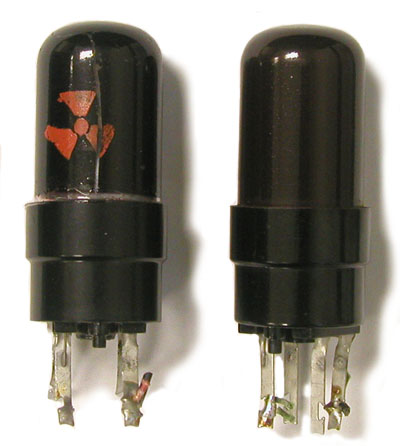
A wide variety of electron tubes have used radioactive material: voltage regulators, spark-gap tubes, voltage sensitive switching tubes, glow lamps, etc. In general, such tubes consist of a glass envelope, a fill gas, a radioactive source, an anode and an unheated (cold) cathode.
The various radioactive sources that have been used in these devices include H-3, C-14, Co-60, Ni-63, Kr-85, Cs-137, Pm-147, Pb-210, Ra-226, and Th-232. If H-3 or Kr-85 is used, it is typically mixed with the fill gas. The purpose of the radioactive source is to ionize the fill gas so that the application of a high voltage across the tube results in an instantaneous current. In the absence of such a source, the initiation of the current would some random event (e.g., light, cosmic ray, background gamma ray) to ionize the gas. The radioactive source therefore speeds up the operation of the tube and ensures that the tube output is steady and not subject to random fluctuations.
In the photo to the right, the tube with the hand-painted red trefoil is a Western Electric 346B tube that contains radium. The solid black tube is a Western Electric 346C tube that contains Kr-85. The tubes are painted to eliminate the random ionizing events in the tube gas that would occur if light got inside. This produces a steadier tube performance.
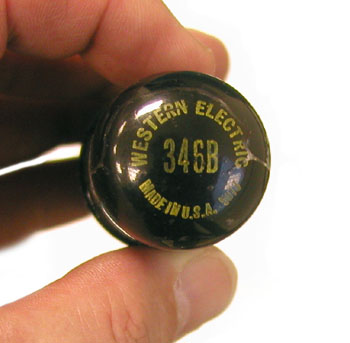
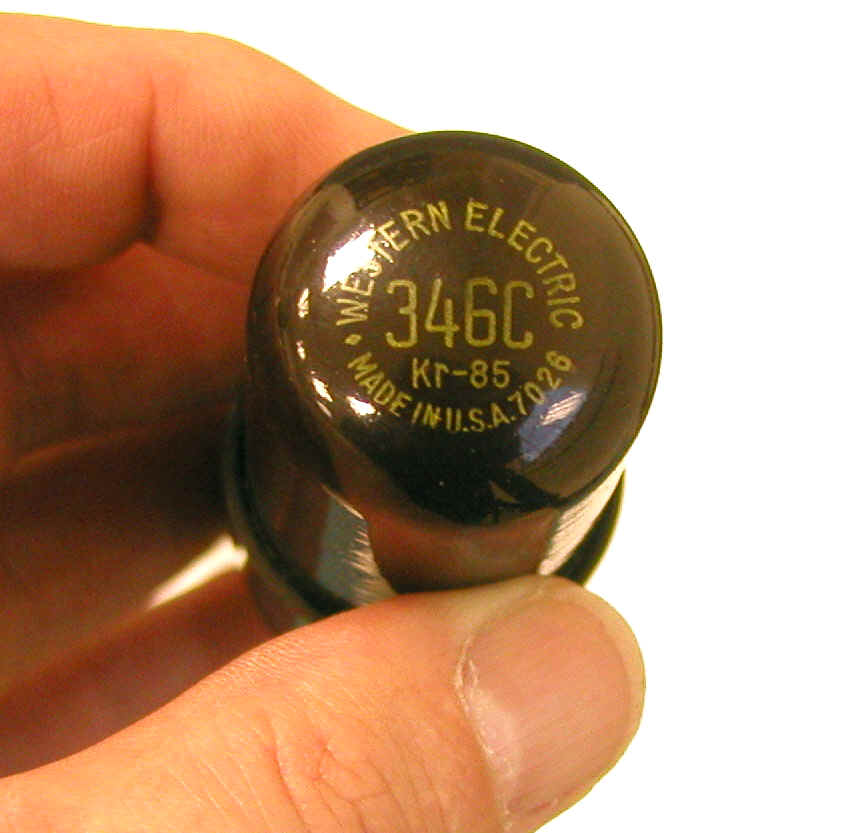
According to the data sheets for the 346B and 346C tubes (provided by jay Damkoehler), they are "for use in relay, voltage regulator, or rectifier circuits" and are "especially suitable for use in control circuits such as triggering, counting, or switching apparatus." Regarding the 346B tube "a few types contain a larger quantity of radium bromide in which the radium approximates that found in a luminous dial watch. These types bear a red three-bladed propeller-shaped symbol."
Transmit-Receive Tubes. Their first use seems to have been in the early 1940s when they began to be used as transmit-receive (TR) tubes in radar systems. Their purpose was to disconnect the receiver from the antenna during transmission. In other words, they acted as a switch. Anti transmit-receive disconnect the transmitter from the antenna during reception. These tubes generally employed Co-60, Ra-226 or H-3.
Voltage Regulator Tubes. These tubes act as a protection against sudden changes (transients) in high voltage. Solid state equipment is particularly susceptible to these transients when it is operating off of AC lines. These types of tubes have usually contained less than 1 uCi of Cs-137, Ni-63, Kr-85, or Pb-210. Most of the voltage regulators and surge arrestors manufactured today are small ceramic cylinders with a thin deposit of Ni-63 on one electrode.
Indicator Lamps. These devices have provided light in many different types of electronic devices including cloths washers and dryers, stereos, coffeemakers, and pinball machines. They are often about 25 mm long and 2.5 mm in diameter. Typical activities would be about 20 uCi of H-3, or 0.2 uCi of Kr-85. NUREG-1775 indicated that several hundred million were produced during the 1970s.
Glow Lamps or Spark Gap Tubes. According to NCRP No. 95, these devices have been used as starters for compact fluorescent lamps, and in electric blanket thermostats and other specialty products. The report (1987) claimed that the annual production of these devices was in the millions. The sources generally consisted of 1 to 9 uCi of Co-60, Ni-63, Kr-85, Pm-147, or Th-232. Today, most fluorescent lamp starters use about 5 pCi of Th-232 coated on the inside of a glass tube. The starter is actually a switch that applies the high voltage to the fluorescent lamp after that latter has been given time to warm up. This preheating of the lamp improves its ability to conduct.
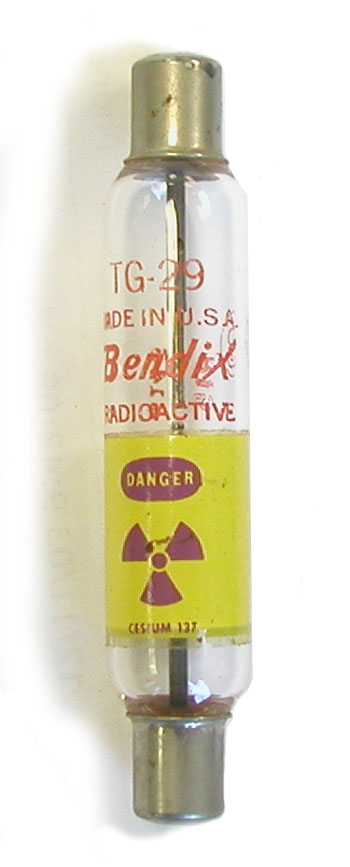
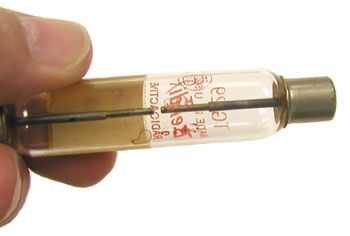
NUREG-1717 provided the following NRC data regarding the annual distribution of electron tubes containing byproduct material during the period of 1970 to 1986.
| Radionuclide | Tubes per Year | uCi per Tube |
|---|---|---|
| H-3 | 8.3 x 106 | 39 |
| Co-60 | 3.2 x 104 | 0.29 |
| Ni-63 | 7.4 x 104 | 1.0 |
| Kr-85 | 7.4 x 107 | 0.28 |
| Cs-137 | 1.7 x 104 | 1.0 |
| Pm-147 | 2.1 x 106 | 5.6 |
Dose Estimates
Routine Use
NUREG-1717 estimated the doses to an occupant in a home from five electron tubes that contained either, H-3, Co-60, Kr-85, Cs-137, or Pm-147. It was assumed that for a given nuclide, each of the five tubes contained the activity presented in the previous table. For the calculations, it was assumed that the occupant spent 6,000 hours per year in the home. It was also assumed that the average distance to one tube was 1 meter, the average distance to two tubes was 3 meters and the average distance to the remaining two tubes was 6 meters. The dose was due to the emission of gamma rays and bremsstrahlung. In the case of tritium, the dose was due to airborne tritium—a leakage rate from the tubes of 2.5 ppm per hour was assumed.
| Radionuclide | uCi per Tube | Effective Dose Equivalent |
|---|---|---|
| H-3 | 39 | <0.001 mrem/year |
| Co-60 | 0.29 | 2 mrem/year |
| Kr-85 | 0.28 | 0.004 mrem/year |
| Cs-137 | 1.0 | 2 mrem/year |
| Pm-147 | 5.6 | <0.001 mrem/year |
NUREG-1717 also calculated the dose to an individual exposed to a single tube in a work environment. In this scenario, the individual was 1 meter away from the tube for 2,000 hours per year. In the case of a tritium containing tube, it was assumed that the equilibrium concentration in the air due to leakage was 4.9 pCi/m3. The resulting effective dose equivalents when the tube contained the maximum activity allowed by the exemptions were as follows:
| Radionuclide | uCi per Tube | Effective Dose Equivalent |
|---|---|---|
| H-3 | 150 | 5 mrem/year |
| Co-60 | 0.29 | 2 mrem/year |
| Kr-85 | 0.28 | 0.1 mrem/year |
| Cs-137 | 1.0 | 2 mrem/year |
| Pm-147 | 5.6 | 0.001 mrem/year |
Accidents and Misuse
NUREG-1717 estimated the doses due to a variety of non-routine situations (e.g., carrying a tube in a pocket, residential fires and warehouse fires), but the largest dose by far was due to the crushing of a microwave receiver protector tube containing the maximum activity of tritium permitted by the exemption (150 mCi). The potential dose to an individual crushing such a tube was estimated at 1000 mrem (1 rem).
Pertinent Regulations
30.15 Certain items containing byproduct material.
(a) Except for persons who apply byproduct material to, or persons who incorporate
byproduct material into, the following products, or persons who initially transfer for sale or distribution the following products containing byproduct material, any person is exempt from the requirements for a license set forth in section 81 of the Act and from the regulations in parts 20 and 30 through 36 and 39 of this chapter to the extent that such person receives, possesses, uses, transfers, owns, or acquires the following products:
. . . . .
(8) Electron tubes: Provided, Tthat each tube does not contain more than one of the following specified quantities of byproduct material:
(i) 150 millicuries of tritium per microwave receiver protector tube or 10 millicuries of tritium per any other electron tube;
(ii) 1 microcurie of cobalt-60;
(iii) 5 microcuries of nickel-63;
(iv) 30 microcuries of krypton-85;
(v) 5 microcuries of cesium-137;
(vi) 30 microcuries of promethium-147;
And provided further, that the levels of radiation from each electron tube containing byproduct material do not exceed 1 millirad per hour at 1 centimeter from any surface when measured through 7 milligrams per square centimeter of absorber.
For purposes of this paragraph ‘‘electron tubes’’ include spark gap tubes, power tubes, gas tubes including glow lamps, receiving tubes, microwave tubes, indicator tubes, pickup tubes, radiation detection tubes, and any other completely sealed tube that is designed to conduct or control electrical currents.
References
- Data sheets for the Western Electric 346B and 346C electron tubes. AT&T 1962.
- Radiation Exposure of the U.S. Population from Consumer Products and Miscellaneous Sources. NCRP Report No. 95; 1987.
- Nuclear Regulatory Commission. Systematic Radiological Assessment of Exemptions for Source and Byproduct Materials. NUREG 1717. June 2001.
